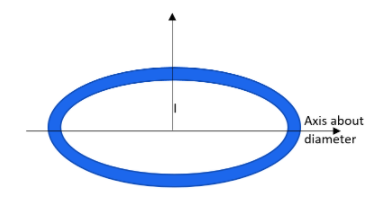
The moment of inertia of a circular ring about an axis which is passing through its centre and normal to its plane is $I$. Then, what will be the moment of inertia about its diameter?
$\begin{align}
& A.I \\
& B.\dfrac{I}{2} \\
& C.\dfrac{I}{8} \\
& D.\dfrac{I}{4} \\
\end{align}$
Answer
557.4k+ views
Hint: The perpendicular axes theorem is the basis for solving out this question. The moment of inertia in the Z-axis will be equivalent to the moment of inertia along the Y-axis and the moment of inertia along the X-axis. Substitute the moment of inertia in each axis and arrive at the correct answer. This will help you in solving this question.
Complete step by step answer:
From the perpendicular axes theorem, we can write that,
The moment of inertia in the Z-axis will be equivalent to the moment of inertia along the Y-axis and the moment of inertia along the X-axis.
That is we can write that,
${{I}_{Z}}={{I}_{X}}+{{I}_{Y}}$
As the moment of inertia along the Z-axis has been mentioned in the question as,
${{I}_{Z}}=I$
And also about the diameter the moment of inertia can be written as,
${{I}_{X}}={{I}_{Y}}={I}'$
Let us substitute the values in the equation as,
\[I={I}'+{I}'\]
Simplifying this equation will give,
\[\begin{align}
& I=2{I}' \\
& \therefore {I}'=\dfrac{I}{2} \\
\end{align}\]
Therefore the answer has been calculated. The answer has been mentioned as option B.

Note: The usage of this theorem is having a great role in calculating the moment of inertia of the body. It is generally used to calculate the moment of inertia of the planar objects. This theorem can be even useful in building up the moments of inertia of the three dimensional objects such as the cylinders by dividing it into different planar disks and summing up the moments of inertia of the total disks. The moment of inertia is the quantity which is the tendency to oppose the angular acceleration.
Complete step by step answer:
From the perpendicular axes theorem, we can write that,
The moment of inertia in the Z-axis will be equivalent to the moment of inertia along the Y-axis and the moment of inertia along the X-axis.
That is we can write that,
${{I}_{Z}}={{I}_{X}}+{{I}_{Y}}$
As the moment of inertia along the Z-axis has been mentioned in the question as,
${{I}_{Z}}=I$
And also about the diameter the moment of inertia can be written as,
${{I}_{X}}={{I}_{Y}}={I}'$
Let us substitute the values in the equation as,
\[I={I}'+{I}'\]
Simplifying this equation will give,
\[\begin{align}
& I=2{I}' \\
& \therefore {I}'=\dfrac{I}{2} \\
\end{align}\]
Therefore the answer has been calculated. The answer has been mentioned as option B.

Note: The usage of this theorem is having a great role in calculating the moment of inertia of the body. It is generally used to calculate the moment of inertia of the planar objects. This theorem can be even useful in building up the moments of inertia of the three dimensional objects such as the cylinders by dividing it into different planar disks and summing up the moments of inertia of the total disks. The moment of inertia is the quantity which is the tendency to oppose the angular acceleration.
Recently Updated Pages
Why are manures considered better than fertilizers class 11 biology CBSE

Find the coordinates of the midpoint of the line segment class 11 maths CBSE

Distinguish between static friction limiting friction class 11 physics CBSE

The Chairman of the constituent Assembly was A Jawaharlal class 11 social science CBSE

The first National Commission on Labour NCL submitted class 11 social science CBSE

Number of all subshell of n + l 7 is A 4 B 5 C 6 D class 11 chemistry CBSE

Trending doubts
What is meant by exothermic and endothermic reactions class 11 chemistry CBSE

10 examples of friction in our daily life

One Metric ton is equal to kg A 10000 B 1000 C 100 class 11 physics CBSE

1 Quintal is equal to a 110 kg b 10 kg c 100kg d 1000 class 11 physics CBSE

Difference Between Prokaryotic Cells and Eukaryotic Cells

What are Quantum numbers Explain the quantum number class 11 chemistry CBSE




